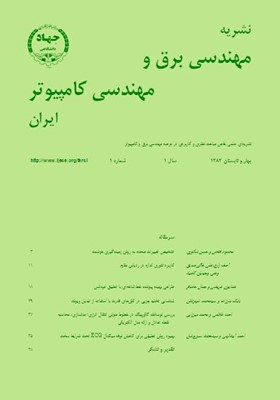شناسايي تخليه جزيي در كابلهاي قدرت با استفاده از تبديل ويولت
محورهای موضوعی : مهندسی برق و کامپیوتربابک بدرزاده 1 , سيدمحمد شهرتاش 2
1 - دانشگاه RGU انگلستان
2 - دانشگاه علم و صنعت ایران
کلید واژه: تبديل ویولتپردازش سيگنال ديجيتالشناسايي پيوسته تخليه جزييكابل,
چکیده مقاله :
در اين مقاله به شناسايي پيوسته پديده تخليه جزيي در كابلهاي قدرت پرداخته شده است. مشكل اساسي در اندازهگيري تخليه جزيي كوچك بودن سيگنال است، بطوريكه ممكن است سيگنال كاملاً با نويز آميخته شده و اين امكان شناسايي را دشوار ميسازد. به همين جهت اساسيترين اقدام در شناسايي سيگنال تخليه جزيي استفاده از الگوريتمهاي كاهش نويز است كه امروزه به اين منظور غالباً از روشهاي مبتني بر پردازش سيگنال ديجيتال استفاده ميشود. در اين مقاله از الگوريتم نويززدايي مبتني بر ویولت استفاده شده و در انتها نتايج حاصل از بكارگيري اين الگوريتم با دو الگوريتم متداول ديگر (فيلتر پيشبين خطي و فيلترLMS) مقايسه شده است. برخي از ملاحظات اساسي در نويززدايي به روش ویولت انتخاب مناسب سطوح تجزيه و تركيب، تابع مادر، روش بسط سيگنال و روشهاي تعيين مقادير آستانه است كه همگي به تفصيل مورد بحث قرار گرفتهاند. به جهت اثبات كارايي الگوريتم از اطلاعات واقعي بدست آمده از آزمايشهاي ميداني در يك شبكه كابلي 11 كيلو ولتي استفاده شده است .
This paper has proposed an on-line method of partial discharges (PDs) detection. Fundamental difficulty in PD measurement is that PD signal is so minute that can be easily contaminated by huge amount of noise and this makes PD detection rather obscure. Thus, noise reduction algorithms have been extensively deployed to mitigate the noise. Among which, Digital Signal Processing (DSP) techniques are becoming more and more applicable. Compared by linear predictor and Least Mean Square (LMS), a wavelet-based noise reduction algorithm has been utilised. Some significant considerations in wavelet denoising such as selection of level of decomposition and reconstruction, mother wavelets, methods of signal extension,thresholding criterion have been discussed deeply. In order to prove the effectiveness of our algorithm, real data extracted from an 11 kV cable has been used


